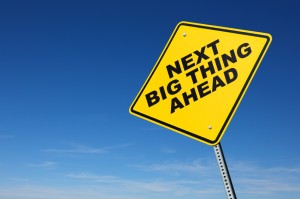Thinking With Your Body
When I’m happy, I smile. A few years ago, I discovered that the reverse is also true: when I smile, I get happy. I’ve also found that standing up straight — as opposed to slouching — can improve my mood and perhaps even my productivity.
It turns out that I was on to something much bigger than I realized at the time. There’s increasing evidence that we think with our bodies as well as our minds. Some of the evidence is simply the way we express our thoughts through physical metaphors. For instance, “I’m in over my head”, “I’m up to my neck in trouble”, “He’s my right hand man”, and so on. Because we use bodily metaphors to express our mental condition, the field of “body thinking” is often referred to a metaphor theory. Perhaps more generally, it’s called embodied cognition.
In experiments reported in New Scientist and in Scientific American, we can see some interesting effects. For instance, with people from western cultures, “up” and “right” mean bigger or better while “down” or “left” mean smaller or worse. So, for instance, when volunteers were asked to call out random numbers to the beat of a metronome, their eyes moved upward when the next number was larger and moved downward when the next number was smaller. Similarly, volunteers were asked to gauge the number of objects in a container. When they were asked to lean to the left while formulating their estimate, they guessed smaller numbers on average. When leaning to the right, they guessed larger numbers.
In another experiment, volunteers were asked to move boxes either: 1) from a lower shelf to a higher shelf; or 2) from a higher shelf to a lower shelf. While moving the boxes, they were asked a simple, open-ended question, like: What were you doing yesterday? Those who were moving the boxes upward were more likely to report positive experiences. Those who were moving the boxes downward were more likely to report negative experiences.
When I speak of the future, I often gesture forward — the future is ahead of us. When I speak of the past, I often do the opposite, gesturing back over my shoulder. Interestingly, the Aymara Indians of highlands Bolivia are reported to do the opposite — pointing backward to the future and forward to the past. That seems counter-intuitive to me but the Aymara explain that the future is invisible. You can’t see it. It’s as if it’s behind you where it can quite literally sneak up on you. The past, on the other hand, is entirely visible — it’s spread out in front of you. That makes a lot of sense but my cultural training is so deeply embedded that I find it very hard to point backward to the future. It’s an interesting example of cultural differences influencing embodied cognition.
Where does this leave us? Well, it’s certainly a step away from Descartes’ formulation of the mind-body duality. The body is not simply a sensing instrument that feeds data to the mind. It also feed thoughts and influences our moods in subtle ways. Yet another reason to take good care of your body.
Creativity in Five Steps

Just five more steps.
How does creativity happen? Is there a pattern — more or less standard — that we can repeat? Is there a process that can lead us from ordinary beginnings to extraordinary ends? Mihaly Csikszentmihalyi — while not guarateeing results — writes that creativity typically evolves through five stages.
The first stage is preparation. Basically, you need to know the rules before you break them. Thomas Kuhn writes that scientific paradigms reflect a basic consensus of how the world operates. Prior to Copernicus, the astronomical paradigm held that the earth was the center of the universe. Before Copernicus could change the paradigm, he had to immerse himself in it. Only then could he make the observations that changed the paradigm.
The second phase is incubation, “… during which ideas churn around below the threshold of consciousness.” This is when I like to go for a walk. I like to lay things aside, clear my head, and let my mind wander. It’s a haphazard process — sometimes nothing happens. Sometimes I simply forget what I was thinking about. Other times, however, something bubbles up that’s worth capturing. (One of the reasons I write this blog is to double back on my own thinking, recall what I wrote months ago, and perhaps make connections I would otherwise miss).
Third, is the insight — the Aha moment. As we saw in the article on sleepiness and creativity (click here), focusing intently on the problem at hand may actually inhibit the Aha experience. When you focus, you block out random thoughts and stray ideas. But it’s those very thoughts and ideas that may produce the insight. When you’re tired — or when you can induce your mind to wander — those stray thoughts are not blocked out and can help you see things more creatively.
Fourth is evaluation, “…when the person must decide whether the insight is valuable and worth pursuing.” This is a difficult step. You think you’ve had a brilliant flash of insight … you start dreaming of a trip to Stockholm to accept a Nobel Prize. On the other hand, maybe it’s just a crackpot idea that your colleagues will laugh at. A thorough understanding of the current paradigm will help. If you’re a master of your discipline, you’ll have a much better idea of which ideas are worth pursuing and which are just goofy.
The fifth step is elaboration. You develop the idea, conduct the research, test your hypotheses, and present your conclusions to your colleagues — who may just rip it apart. As Csikszentmihalyi notes, “This is what Edison was referring to when he said that creativity consists of 1 percent inspiration and 99 percent perspiration.”
Does the five-step process always produce creative innovations? No, not at all. But, if your purpose is to create new ideas, products, and services you should always be cognizant of where you are in the process. Following the process doesn’t guarantee success. But not following it virtually guarantees failure.
You can find Mihaly Csikszentmihalyi’s book here. Thomas Kuhn’s book is here.
Innovation: Making the Connection

Anybody want to connect?
Making connections is the basis of creativity and innovation. It’s very rare that somebody comes up with a full-blown idea on their own. Instead, they master a domain and then extend it. They learn a paradigm and then change it. They make the connection between this idea and that one. They put two and two together.
So, how do you actually make connections? I think of it as a three-level problem. First, we make new connections within our own brains. Second, we connect with other people who are more or less like us. Third, we need to expand our horizons and connect with people who aren’t like us. Here are some practical tips for each level.
In our own brains — as numerous authors have pointed out, the brain is plastic. It can change itself and enrich itself even after it stops growing. Can we teach our brains to make new connections? You betcha:
- Read things (or watch things) that you disagree with. If you only read authors who agree with your political or philosophical bent, you’re only reinforcing existing connections. Reading authors you disagree with will help you establish new connections.
- Use you non-dominant hand more often — connect to your “other” side.
- Study a foreign language — we think with words. Learn some new words and you’ll learn to think differently.
- Play games that exercise your brain — try bridge or crossword puzzles or sudoku. They all require you to see things differently and remember things accurately.
Other people like us — let’s take the context of a company’s headquarters building. How do you build connections between employees? We’re all familiar with team-building exercises. Let’s look at a few less obvious ways to connect:
- Reduce the number of coffee stations — get people to congregate at central locations. As they bump into each other, they’ll talk to each other, too.
- Reduce the number of bathrooms — same idea, get people to congregate in central locations.
- Design physical spaces that get people to carom off each other — look at the old Bell Labs architecture. Long, narrow hallways with offices arrayed along them. Step out of your office and you’re on a highway full of people. It’s hard not to bump into somebody.
- Book clubs — sponsor a book of the month club for all employees. Hint: don’t just do business books. Range farther afield into history, sociology, fiction, and so on.
Other people not like us — who is not like us? Well, if I’m in the accounting department, then sales people are not like me. Making connections with sales people might just lead to great new ideas. I see a lot of team building within departments (a team retreat for the marketing department, for instance) but not so much between departments. Here are a few ideas:
- Random seating — why is it important for accountants to sit with accountants and engineers to sit with engineers? Randomize things so that people sit by people who are different.
- Onboarding programs — help new employees make contacts across the company; not just in their own department. Early connections last a long time.
- Team building with other departments — emphasize collaboration rather than competitions. Form coss-departmental teams or go on retreats together. Get people to know each other.
- Travel more — face-to-face meetings are the best way to get to know people, especially people who are different from you.
- Connect with customers — develop programs that require your employees to work with your customers. Make the effort to bridge the gap.
Are You More Creative When You’re Sleepy?

Gosh, I’m feeling so creative.
I’m a morning person. I wake up every day full of plans and optimism. I just know I can solve the problems of the world today. (Yes, I’m a bit obnoxious). In the evening, on the other hand, I run out of gas. I like to do a little light reading and go to bed early. A psychologist would say that the morning is my “optimal” time while the evening is my “non-optimal” time.
It seems logical that I would be more creative during my optimal time, no? Well, … maybe not. According to two psychology professors, Mareike B. Wieth and Rose T. Zacks, your non-optimal times may be your better times for creativity.
In a research paper published in 2011 (click here or see full citation below), Wieth and Zacks determined the optimal times — morning or evening — of 428 randomly selected students and then asked them to complete, three “analytic” problems and three “insight” problems. Analytic problems “…require the solver to ‘grind out the solution’ by searching through and narrowing the problem space.” In other words, you start on a path and stay on that path until you find the solution.
Insight problems, on the other hand, “are often solved suddenly with a ‘flash of illuminance’ … or what has also been called an ‘‘Aha’’ experience where the solution seems to just pop into mind.” The process of solving an insight problem is also different. People typically start on a given path, hit a wall, and then jump to a different path. As the authors phrase it, “…to move past the impasse, the solver must break away from his or her focus on the current representation of the problem and find an alternative way of structuring the problem space.”
Students completed their six problems at randomly assigned times. Some completed the problems during their optimal times, others during their non-optimal times. The results varied by problem type. Students solved analytical problems better when they worked during their optimal time. For insight problems, however, students were more successful when they worked during their non-optimal times.
Why would that be? Wieth and Zacks hypothesize that it has to with “…inhibitory processes [that] control the flow of information from thought and perception.” Simply put, we can focus better during our optimal times because our inhibitory processes block out distracting information. That’s good for grind-it-out problems — our inhibitory processes help us focus on the solution path. With insight problems, on the other hand, distracting information can actually help us jump to the right path. During our non-optimal times, our inhibitory processes are less effective. We’re less focused and our mind wanders more. More “distracting” information enters our thoughts. All of that helps us discern other paths that can lead to an Aha experience.
So, do you want to be more creative? Just stay up late and let your mind wander. That’s not so hard.
Mareike B. Wieth & Rose T. Zacks (2011): Time of day effects on problem solving: When the non-optimal is optimal, Thinking & Reasoning, 17:4, 387-401. This work was supported by National Institute on Aging Grant R37 AG04306.
More Creative Creativity

I’m a traditionalist. And an iconoclast.
In his classic research on creativity, Mihaly Csikszentmihalyi wrote that creative personalities often display ten contrasting characteristics. In previous articles, we’ve looked at the first six. (Click here and here). Today let’s look at the final four.
In all cultures, men are brought up to be “masculine” and to disregard and repress those aspects of their temperament that the culture regards as “feminine,” whereas women are expected to do the opposite. Creative individuals to a certain extent escape this rigid gender role stereotyping. Csikszentmihalyi refers to this as androgyny — not just in the sexual sense but in the broader, cultural sense: “a person’s ability to be at the same time aggressive and nurturant, sensitive and rigid, dominant and submissive…” In his sample of creative personalities, Csikszentmihalyi found that the men were more sensitive and the women more assertive than their cultural norms would suggest.
Generally, creative people are thought to be rebellious and independent. Yet it is impossible to be creative without having first internalized a domain of culture. To master the vast knowledge of a given discipline, novices need to work very hard. They wouldn’t work so hard unless they believed deep knowledge of the field were important. Thus, in some senses, they are traditionalists as much as they are iconoclasts.
Most creative persons are very passionate about their work, yet they can be extremely objective about it as well. To perform difficult tasks that might take years to complete, one needs to be passionate. Yet to place one’s work against an existing domain’s framework — and to make it credible — one needs to be clear-eyed and objective.
Finally, the openness and sensitivity of creative individuals often exposes them to suffering and pain yet also a great deal of enjoyment. Leading a discipline into a new way of thinking is a lonely job. Being sensitive (as noted above) only complicates the issue. Csikszentmihalyi asks an important question: does suffering lead to creativity or does creativity lead to suffering? Normal people may see divergent thinking and obsessive interest in obscure topics as weird or even deviant. As a result, “the creative person may feel isolated and misunderstood …. Yet when the person is working in the area of his or her expertise, worries and cares fall away, replaced by a sense of bliss. Perhaps the most important quality, the one that is most consistently present in all creative individuals, is the ability to enjoy the process of creation for its own sake.”
So we have ten different contrasting personality types that commonly occur in creative people. In each case, the creative personality appears at two different points on the spectrum. They are both traditionalists and iconoclasts. Smart and naive. Energetic and quiet. Introverts and extroverts. Imaginative and realists. As Csikszentmihalyi points out, “…without the second pole, new ideas will not be recognized. And without the first, they will not be developed to the point of acceptance.”
Click here for Csikszentmihalyi’s book. By the way, his surname is pronounced Six-Cent-Mihaly.
